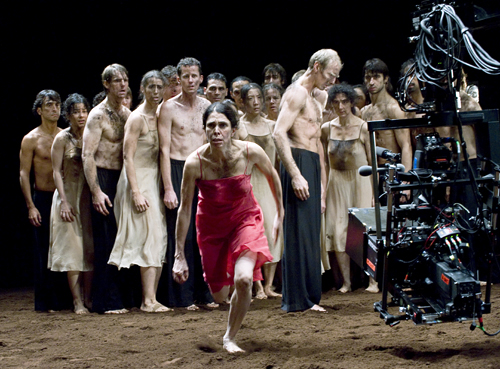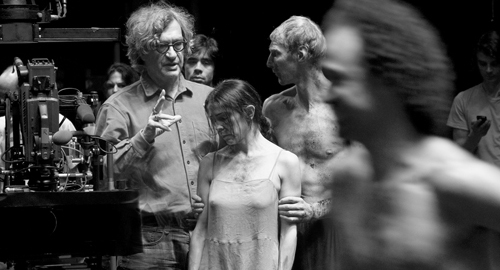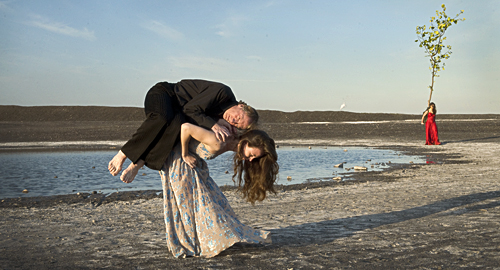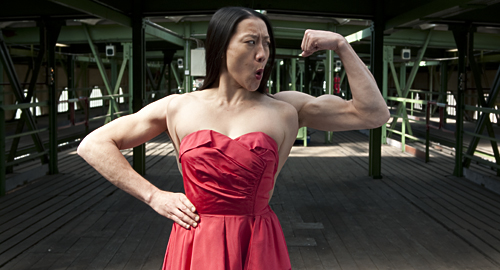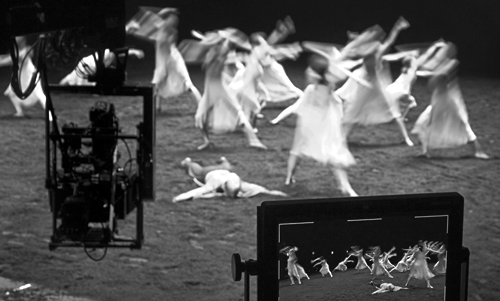PINA (2011) by Wim Wenders is a true 3D masterpiece that combines the cinematic and dance art forms in a powerful, poetic and moving film homage to the late Pina Bausch, a brilliant, innovative choreographer.
Wim Wenders was assisted on Pina by cinematographer Hélène Louvart, AFC, 3D supervisor François Garnier and director of stereography Alain Derobe.
I wrote an article about Pina for the September 2011 issue of American Cinematographer. Wenders was very busy on another project when I was writing the article, but kindly accepted to answer some written questions which I featured on my blog on theasc.com. I thank him for the time he took to write this thoughtful, honest and passionate text!
click on images for closer view
+++
emotion
Benjamin B: Can you talk about the emotional impact of Pina’s work on you?
Wim Wenders: I was totally overwhelmed when I saw a piece of Pina Bausch for the first time. Nothing had prepared me for it. I didn’t care much about dance, I must admit. I didn’t think that was for me, or concerned me in any way. My girl friend at the time had to drag me into the theatre to see CAFÉ MÜLLER. And then I found myself on the edge of my seat, after 10 minutes, crying, and finally weeping through the entire performance.
What I saw on stage touched me more than anything I had ever seen. It went deep into my heart and really shook me to the bone. This (to me yet unknown) woman by the name of Pina Bausch was showing me more about men and women than the entire history of cinema had done, and all that without a WORD! I was eager to see more, and could not get enough of Pina’s work. (Luckily, there were already 20 pieces at the time!) She had created a new art form, indeed, that didn’t owe much to neither conventional dance nor theatre…
You see, as a film director I fancied I knew something about the language of our bodies. We deal with actors, sometimes famous ones, we often tell them what to do, we sometimes correct them. And after all, the actor’s “presence”, that magic thing some of them have to appeal to the camera, what else is it than their body language? So, in my profession, we think we are experts in that. And then you see the work of Pina Bausch, and you realize: we are all analphabets of that language, we know little or nothing in relation to Pina about how to decipher that most fundamental language on Earth.
I have known Pina (and her work) for over 20 years, and I cannot possibly grasp how much that encounter influenced me. A couple of years after I saw her work for the first time I made Wings of Desire. Which is probably the most “choreographed” film I ever made, and which certainly owes a lot to Pina. (More on subconscious levels, I guess, than on any obvious first-hand “inspiration”.)
BB: Is there a scene in PINA that you particularly liked directing and why?
WW: Yes, one little moment. It is a quote from the piece TEN CHI … An older man is carrying his daughter on his back. He walks leaned over, like carrying a big load, and she is cuddled on his back like a baby. And then he stops and she glides down from his back. And then the unimaginable happens: she bends down, and her father climbs onto her back and also turns into a baby, and she carries him for a stretch of the path. And then she stops and they change parts again. Father and daughter cross the entire stage like this…
We shot this outdoors, and I was looking for the longest time for the ideal place for this little scene, until I found a location, in an industrial area near Wuppertal, that looked like a moonscape. I have seen this father and daughter movement countless times, on stage, and then in the editing room of course, but even now, in the finished film, I get goose-pimples when I see it…
+++
presence
BB: How do you feel about placing people or objects in front of the screen? Can you give an example from the film?
WW: Hard to give ONE example. In 3D there is this whole new aspect to consider: where to you place your characters in space? Are they on the screen level, or behind, or before it? That question appears with every shot. You have to organize the entire depth of the space you have available. In a way that’s the basic work in 3D that you expect, also from watching other 3D films. What really hit me more during the shoot, a whole new experience, was that the actors’ bodies themselves appears so differently.
All of a sudden, these bodies have VOLUME. They are round, and voluptuous, no longer flat surfaces as they have always been on the screen. That presence of the body has surprised me most, more than depth and space as such. And in a way, I felt we were on new territory here with PINA, as the dancers and that incredibly physical work they are doing were the main subject of the film. There was a phenomenal affinity between 3D and our subject. They both brought out the best in each other. Not only was 3D perfect to represent dance, dance also really brought out the essence of 3D, it felt.
BB: Can you talk about how 3D conveys the presence of performers differently than 2D? Is there a shot that comes to mind?
WW: The most simple shot of the film was the most striking one in that regard. It was a recurring set-up, some sort of a “silent portrait” that we made with each of the dancers, over a longer shooting period. They each sat in front of the camera, as if it was a sitting for a painter, or photographer, eventually directing their look straight into the lens. I always sent the entire crew away, when the stereo cameras were running, so I was alone with each of the actors/dancers, and we would have a really intimate situation. I sat behind the rig with our TRANSVIDEO monitor on my lap, so I became invisible for the person in front of the cameras, while I could watch in 3D what we were shooting. So there was just a person sitting in front of a three-dimensional camera, and I was watching a live feed on a monitor.
I tell you: it blew my mind! This was the most exciting thing in my 3D experience, I felt, far more compelling than huge crane shots with hundreds of camera positions and a complex choreography. The presence of that person on my 3D monitor was breathtaking. It really felt, for the first time, as if I could actually touch the dancers. There was an aura around them I had never experienced in cinema before. They were THERE is an ever before unseen way! We could use the entire little space – the person on a chair with a wall a feet behind them – for our stereographic representation.
There was nothing “spectacular” about the whole thing, only that the very presence of a human being was utterly spectacular in itself. The face was a real landscape, the body had volume and roundness, “weight”… I cant even put it in words why this was so thrilling and extraordinary. The “reality” of the body, the “existential truth” of this representation, the very miracle of a human being alive not only in front of the camera but also captured absolutely “live-like” by this new medium… it struck me each time we did this shot (and I went through the experience each time anew) that this was, indeed, the future of filmmaking, especially of documentary filmmaking.
You always say that great actors have that special “presence” in front of the camera, but here was an even more magnified presence. You can only guess how this would be filled by a great actor in a story that would actually USE this potential of 3D and not just treat the new language as a production value in itself. The real attraction of 3D is how people can appear in this new space! I have just not seen that yet in a movie. 3D movies are all about themselves, it seems to me, all self-fulfilling prophecies. There was only one masterpiece in the genre so far, and that was Avatar. Ever since I wait for a film that would incorporate 3D with all its new possibilities for storytelling.
+++
wide
BB: How does 3D change your mise en scène ?
WW: What changed most for my own approach to filmmaking and directing was the use of lenses. The use of a wide angle, let’s say a 24mm lens for a huge wide shot (if we are talking 35mm film lenses) or a 32 to 38 for a medium wide shot, or a 50-65 for a close-up, or an 135 for a tight close-up… As a film director (like most of my colleagues) I have that in my blood, I “think” in set-ups and focal lengths that go with it.
That just didn’t work for me in 3D. I soon realized that the ideal lens for a 3D shoot was the one that came as close as possible to our human eye and its angle of perception. For our SONY 1500 cameras that became a set of 10mm Zeiss prime lenses, and we shot the entire film with that focal length, with the exception of very few closer shots that we did on a 14mm. (Which is still relatively wide.) I just thought that changing lenses did some harm to the stereographic perception. If you changed focal length when going from a wider shot to a closer one the entire space would be compressed. I experienced that as unpleasant when I made the first cuts in 3D and started to refrain from changing lenses. We would just go closer or wider with the camera, this way respecting as much as possible a 3D approach that was as “physiologically correct” as possible.
+++
future
BB: What do you think is the future of 3D for features and documentaries?
WW: There is no future if the new medium isn’t done more justice soon! If the studios keep producing trash with it, strictly action-based roller-coaster rides, the medium will collapse. It can do so much more!!! I can’t wait to see filmmakers, independent directors and authors and documentary crews take up 3D, make the best out of it and use it finally to its full potential. Stories that are “space adventures”, not in outer space, but on our own planet. Intimate stories of real people, not just of fantasy characters! I can’t wait to see the first round of documentaries exploring the new three-dimensional language to its max, taking us into the lives and the work of people in ways that we have never seen before. THEN 3D has a brilliant future, then it is a change comparable to the step from silent movies to sound!
BB: How about you personally, which kind of projects would you like to shoot in 3D or 2D in the future?
WW: I have done a couple of short films since PINA, documentary-style, or as an installation for the Architecture Biennale in Venice. I am working with a writer on a feature film that could be shot in 3D, an intimate story that would have the “affinity” to 3D that I mentioned before. I am also very tempted to shoot another feature-length documentary in 3D, with a very small crew, travelling a lot and filming in remote places. I’m really addicted to 3D, I must say. Very hard to return to conventional flat screens once you have tasted the thrill of a three-dimensional shoot.
+++
watch on YouTube
+++
Links
Wim Wenders’ official web site
Wikipedia article on Pina Bausch
+++
This was originally published on thefilmbook blog on theasc.com web site
Photos by Donatella Wenders, courtesy of Road Movies
+++

